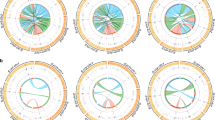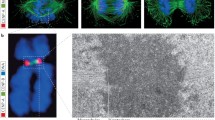Abstract
Although centromere protein B (CENP-B) is a highly conserved mammalian centromere protein, its function remains unknown. The presence of the protein is required to form artificial satellite DNA-based centromeres de novo, yet cenpb knockout mice are viable for multiple generations with no mitotic or meiotic defects, and the protein is not present at fully functional neocentromeres. Previous studies have suggested that the presence of functionally redundant paralogues of CENP-B may explain the lack of a phenotype in knockout mice, and the related Tigger-derived (TIGD) family of proteins has been implicated as the most likely candidate for such paralogues. Here, we describe an investigation of the centromere-binding properties of the three TIGD proteins most highly related to CENP-B through phylogenetic analysis through EGFP fusion studies and immunocytochemistry. Although two of the three proteins bound to human centromeres with low affinity when overexpressed as fusion proteins, the strongest candidate, TIGD3, demonstrated no native centromeric binding when using raised antibodies, either in human cells or in cenpb −/− mouse ES cells. We conclude that the existence of functional CENP-B paralogues is highly unlikely and that CENP-B acts alone at the centromere. Based on these data, we suggest a new, meiotic drive model of CENP-B action during centromere repositioning in evolution.






Similar content being viewed by others
References
Amor DJ, Bentley K, Ryan J, Perry J, Wong L, Slater H, Choo KHA (2004) Human centromere repositioning “in progress”. Proc Natl Acad Sci U S A 101(17):6542–6547. doi:10.1073/pnas.0308637101
Basu J, Stromberg G, Compitello G, Willard HF, Bokkelen GV (2005) Rapid creation of BAC-based human artificial chromosome vectors by transposition with synthetic alpha-satellite arrays. Nucleic Acids Res 33(2):587–596. doi:10.1093/nar/gki207
Baum M, Clarke L (2000) Fission yeast homologs of human CENP-B have redundant functions affecting cell growth and chromosome segregation. Mol Cell Biol 20(8):2852–2864
Capozzi O, Purgato S, D’Addabbo P, Archidiacono N, Battaglia P, Baroncini A, Capucci A, Stanyon R, Valle GD, Rocchi M (2009) Evolutionary descent of a human chromosome 6 neocentromere: a jump back to 17 million years ago. Genome Res 19(5):778–784. doi:10.1101/gr.085688.108
Casola C, Hucks D, Feschotte C (2008) Convergent domestication of pogo-like transposases into centromere-binding proteins in fission yeast and mammals. Mol Biol Evol 25(1):29–41. doi:10.1093/molbev/msm221
Grady DL, Ratliff RL, Robinson DL, McCanlies EC, Meyne J, Moyzis RK (1992) Highly conserved repetitive DNA sequences are present at human centromeres. Proc Natl Acad Sci U S A 89(5):1695–1699
Halverson D, Baum M, Stryker J, Carbon J, Clarke L (1997) A centromere DNA-binding protein from fission yeast affects chromosome segregation and has homology to human CENP-B. J Cell Biol 136(3):487–500
Henikoff S, Ahmad K, Malik HS (2001) The centromere paradox: stable inheritance with rapidly evolving DNA. Science 293(5532):1098–1102
Higgins MJ, Wang HS, Shtromas I, Haliotis T, Roder JC, Holden JJ, White BN (1985) Organization of a repetitive human 1.8 kb KpnI sequence localized in the heterochromatin of chromosome 15. Chromosoma 93(1):77–86
Howman EV, Fowler KJ, Newson AJ, Redward S, MacDonald AC, Kalitsis P, Choo KH (2000) Early disruption of centromeric chromatin organization in centromere protein A (cenpa) null mice. Proc Natl Acad Sci U S A 97(3):1148–1153
Hudson DF, Fowler KJ, Earle E, Saffery R, Kalitsis P, Trowell H, Hill J, Wreford NG, de Kretser DM, Cancilla MR, Howman E, Hii L, Cutts SM, Irvine DV, Choo KH (1998) Centromere protein B null mice are mitotically and meiotically normal but have lower body and testis weights. J Cell Biol 141(2):309–319
Huelsenbeck JP, Ronquist F (2001) MrBayes: Bayesian inference of phylogenetic trees. Bioinformatics 17(8):754–755
Irelan JT, Gutkin GI, Clarke L (2001) Functional redundancies, distinct localizations and interactions among three fission yeast homologs of centromere protein-B. Genetics 157(3):1191–1203
Irvine DV, Amor DJ, Perry J, Sirvent N, Pedeutour F, Choo KHA, Saffery R (2004) Chromosome size and origin as determinants of the level of CENP-A incorporation into human centromeres. Chromosome Res 12(8):805–815. doi:10.1007/s10577-005-5377-4
Kapoor M, de Oca M, Luna R, Liu G, Lozano G, Cummings C, Mancini M, Ouspenski I, Brinkley BR, May GS (1998) The cenpb gene is not essential in mice. Chromosoma 107(8):570–576
Kipling D, Warburton PE (1997) Centromeres, CENP-B and Tigger too. Trends Genet 13(4):141–145
Lee C, Wevrick R, Fisher RB, Ferguson-Smith MA, Lin CC (1994) Human centromeric DNAs. Hum Genet 100(3–4):291–304
Liu W, Seto J, Donovan G, Toth M (2002) Jerky, a protein deficient in a mouse epilepsy model, is associated with translationally inactive mRNA in neurons. J Neurosci 22(1):176–182
Liu W, Seto J, Sibille E, Toth M (2003) The RNA binding domain of Jerky consists of tandemly arranged helix-turn-helix/homeodomain-like motifs and binds specific sets of mRNAs. Mol Cell Biol 23(12):4083–4093
Marshall OJ (2004) PerlPrimer: cross-platform, graphical primer design for standard, bisulphite and real-time PCR. Bioinformatics 20(15):2471–2472. doi:10.1093/bioinformatics/bth254
Marshall OJ, Chueh AC, Wong LH, Choo KHA (2008a) Neocentromeres: new insights into centromere structure, disease development, and karyotype evolution. Am J Hum Genet 82(2):261–282. doi:10.1016/j.ajhg.2007.11.009
Marshall OJ, Marshall AT, Choo KHA (2008b) Three-dimensional localization of CENP-A suggests a complex higher order structure of centromeric chromatin. J Cell Biol 183(7):1193–1202. doi:10.1083/jcb.200804078
Masumoto H, Ikeno M, Nakano M, Okazaki T, Grimes B, Cooke H, Suzuki N (1998) Assay of centromere function using a human artificial chromosome. Chromosoma 107(6–7):406–416
Masumoto H, Masukata H, Muro Y, Nozaki N, Okazaki T (1989) A human centromere antigen (CENP-B) interacts with a short specific sequence in alphoid DNA, a human centromeric satellite. J Cell Biol 109:1963–1973
Ohzeki J, Nakano M, Okada T, Masumoto H (2002) CENP-B box is required for de novo centromere chromatin assembly on human alphoid DNA. J Cell Biol 159(5):765–775. doi:10.1083/jcb.200207112
Okada T, Ohzeki JI, Nakano M, Yoda K, Brinkley WR, Larionov V, Masumoto H (2007) CENP-B controls centromere formation depending on the chromatin context. Cell 131(7):1287–1300. doi:10.1016/j.cell.2007.10.045
Okamoto Y, Nakano M, Ohzeki JI, Larionov V, Masumoto H (2007) A minimal CENP-A core is required for nucleation and maintenance of a functional human centromere. EMBO J 26(5):1279–1291. doi:10.1038/sj.emboj.7601584
Perez-Castro AV, Shamanski FL, Meneses JJ, Lovato TL, Vogel KG, Moyzis RK, Pedersen R (1998) Centromeric protein B null mice are viable with no apparent abnormalities. Dev Biol 201(2):135–143
Piras FM, Nergadze SG, Magnani E, Bertoni L, Attolini C, Khoriauli L, Raimondi E, Giulotto E (2010) Uncoupling of satellite DNA and centromeric function in the genus Equus. PLoS Genet 6(2):e1000,845. doi:10.1371/journal.pgen.1000845
Ronquist F, Huelsenbeck JP (2003) MrBayes 3: Bayesian phylogenetic inference under mixed models. Bioinformatics 19(12):1572–1574
Smit AF, Riggs AD (1996) Tiggers and DNA transposon fossils in the human genome. Proc Natl Acad Sci U S A 93(4):1443–1448
Tomascik-Cheeseman L, Marchetti F, Lowe X, Shamanski FL, Nath J, Pedersen RA, Wyrobek AJ (2002) CENP-B is not critical for meiotic chromosome segregation in male mice. Mutat Res 513(1–2):197–203
Toth M, Grimsby J, Buzsaki G, Donovan GP (1995) Epileptic seizures caused by inactivation of a novel gene, jerky, related to centromere binding protein-B in transgenic mice. Nat Genet 11(1):71–75. doi:10.1038/ng0995-71
Ventura M, Weigl S, Carbone L, Cardone MF, Misceo D, Teti M, D’Addabbo P, Wandall A, Björck E, de Jong PJ, She X, Eichler EE, Archidiacono N, Rocchi M (2004) Recurrent sites for new centromere seeding. Genome Res 14(9):1696–1703. doi:10.1101/gr.2608804
de Villena FPM, Sapienza C (2001) Nonrandom segregation during meiosis: the unfairness of females. Mamm Genome 12(5):331–339. doi:10.1007/s003350040003
Waldron R, Moore T (2004) Complex regulation and nuclear localization of JRK protein. Biochem Soc Trans 32(Pt 6):920–923. doi:10.1042/BST0320920
Warburton PE (2004) Chromosomal dynamics of human neocentromere formation. Chromosome Res 12(6):617–626. doi:10.1023/B:CHRO.0000036585.44138.4b
Zwick ME, Salstrom JL, Langley CH (1999) Genetic variation in rates of nondisjunction: association of two naturally occurring polymorphisms in the chromokinesin nod with increased rates of nondisjunction in Drosophila melanogaster. Genetics 152(4):1605–1614
Acknowledgements
This work was supported by the National Health and Medical Research Council of Australia and the Victorian Government’s Operational Infrastructure Support Program. KHAC is a Senior Principal Research Fellow of NHMRC.
Author information
Authors and Affiliations
Corresponding authors
Rights and permissions
About this article
Cite this article
Marshall, O.J., Choo, K.H.A. Putative CENP-B paralogues are not present at mammalian centromeres. Chromosoma 121, 169–179 (2012). https://doi.org/10.1007/s00412-011-0348-3
Received:
Revised:
Accepted:
Published:
Issue Date:
DOI: https://doi.org/10.1007/s00412-011-0348-3




